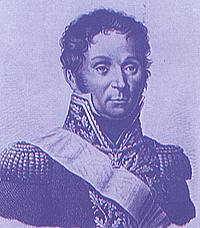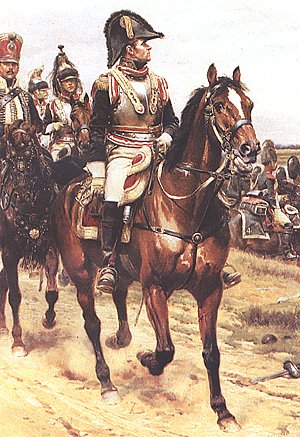Napoleon's Cavalry Commanders
3: General Francois-Etienne Kellermann
Terry J Senior, (UK)
| |
Kellermann was the son of le Marechal and first duc de Valmy, was an outstanding leader with a record to match both Montbrun and LaSalle. He also possessed other skills such as diplomacy, and was very well educated and a talented linguist. He displayed these talents to good effect, first in America when he went as assistant to Chevalier Ternan and then in Portugal in August 1808 when putting together the terms of the Convention of Cintra. This was considered heavily weighted in favour of the French and due in large part to Kellermann’s negotiating skills. It also resulted in the three senior English commanders Wellesley, Burrard and Dalrymple all being recalled to London to give an explanation of their actions. The Convention, signed by both Kellermann for the French and Wellesley for the English, each being considered of equal rank, stated that in exchange for a cessation of hostilities and evacuation of Portugal, the French would receive free transport in English vessels, to a port of their choice for their men, horses, baggage, artillery and other equipment, which also included a certain amount of plunder. Kellermann too, had the ability to read situations as they were developing,
on the battlefield and to take appropriate action. He also, like Montbrun and
LaSalle possessed the necessary skills to control massed cavalry in the field.
Somewhat less dynamic, but perhaps more calculating, he also lacked the
charisma of the Florensac born Montbrun and the Alsatian LaSalle.
At Waterloo in June 1815 Kellermann commanded the 3 rd Cavalry Corps consisting 11e and 12 e Cavalry divisions comprising 2e 3e, 8e, and 11e cuirassiers, 2e and 7e Dragons and 1er and 2e Carabinier regiments having Generals Samuel baron l’Heritier and the veteran Nicolas-Francois vicomte Roussel d’Hurbal as his subordinate Divisional commanders. Roussel-d’Hurbal had a strange active service record. Although born in Neufchataux (Vosges) in September 1763, he had enlisted in the Austrian army in 1782. He had fought against France at Aldenhoven in March 1793, and had become Colonel of the Regiment de Cuirassiers de Maurice de Lichtenstein and had been decorated as Chevalier de l’Ordre Militaire de Marie-Therese in October 1805. He received still more honours from the Austrians, for his good conduct at Essling and it wasn’t until July 1811 that he entered the service of France as a General de Brigade. He thereafter gave good service to France but his career requires more research. Kellermann too was a family man and for several years lived with Italian born Therese Gnudi who was five years older than he. She was the daughter of le Marquis de la Sammartina and was still married to Charles-Philippe Comte Aldrovandi-Marescotti. Therese and Kellermann already had two children, both boys, Felix-Auguste (1799) and Hippolyte (1800). He and Therese married after her divorce came through in 1800 and they subsequently had another boy, Francois-Christophe-Edmond born 21st April 1802 and it was he, who eventually became the third and final duc de Valmy, after Kellermanns death in 1835. Napoleon's Cavalry Commanders
1: General Louis-Pierre Montbrun 2: General Antoine-Louis-Charles LaSalle 3: General Francois-Etienne Kellermann 4: General Jean-Joseph Ange d’Hautpoul 5: General Claude-Pierre Pajol Other CommandersNapoleon's Cavalry Commanders # 6 - # 11
6: General Etienne Marie Antoine Champion de Nansouty 7: General Frederic Louis Henri Walther 8: General Charles Lefebvre Desnouettes 9: General Nicolas Dahlmann 10: General Pierre David (Eduoard) Colbert de Chabanais 11: General Marie Victor Nicolas de Fay Latour Maubourg Napoleon's Cavalry Commanders # 12 - # 14
12: General Claude-Etienne Guyot 13: General Auguste-Francois-Marie de Colbert-Chabanais 14: General Jean-Pierre-Joseph Bruyere Napoleon's Cavalry Commanders # 15 - # 17
15: General Jean-Louis-Brigitte d’Espagne 16: General Louis Lepic 17: General Hippolyte-Marie-Guillaume de Rosnyvinen Comte de Pire Napoleon's Cavalry Commanders # 18 - # 20
18: General Francois Fournier-Sarlovese 19: General Louis-Michel Letort 20: General Edouard-Jean-Baptiste Milhaud Bibliography Back to Table of Contents -- First Empire #66 Back to First Empire List of Issues Back to MagWeb Master Magazine List © Copyright 2002 by First Empire. This article appears in MagWeb (Magazine Web) on the Internet World Wide Web. Other military history articles and gaming articles are available at http://www.magweb.com |

 He had a very short, nonetheless difficult and worrying period during
late 1793 when both he and his father were arrested and imprisoned, his father
being thrown in the infamous l’Abbaye. The charges against him however, were
flimsy and he was soon given his liberty, as was also his father.
He acquired the title duc de Valmy after his father died in September 1820.
His was one of the longest active service careers under Napoleon and
really began when he led the decisive charge at Marengo in June 1800, that
having been made possible by the actions of the diminutive and much
lamented General Louis-Charles-Antoine Desaix.
He had a very short, nonetheless difficult and worrying period during
late 1793 when both he and his father were arrested and imprisoned, his father
being thrown in the infamous l’Abbaye. The charges against him however, were
flimsy and he was soon given his liberty, as was also his father.
He acquired the title duc de Valmy after his father died in September 1820.
His was one of the longest active service careers under Napoleon and
really began when he led the decisive charge at Marengo in June 1800, that
having been made possible by the actions of the diminutive and much
lamented General Louis-Charles-Antoine Desaix.